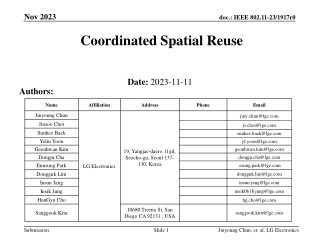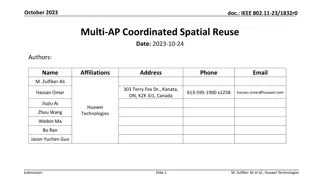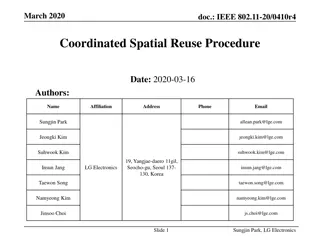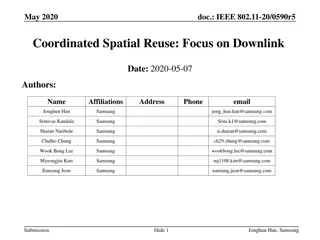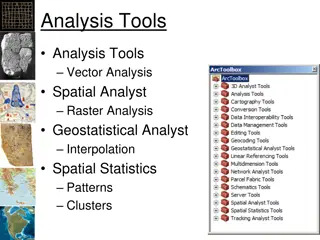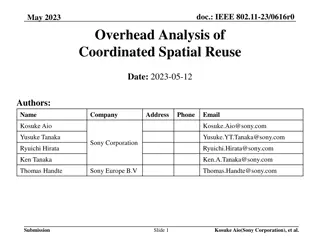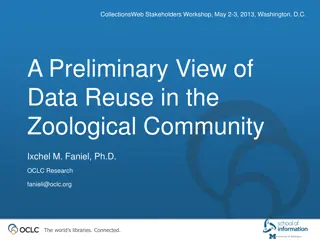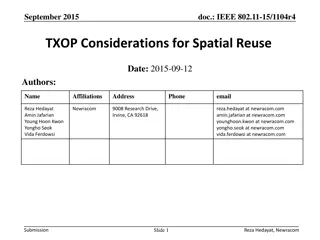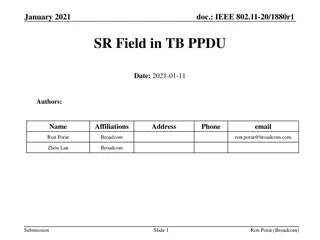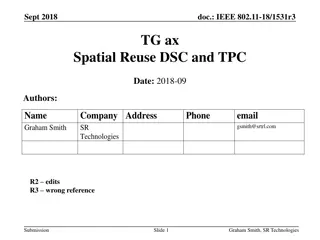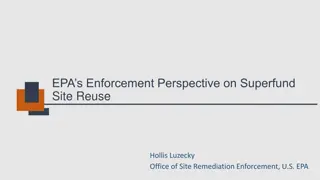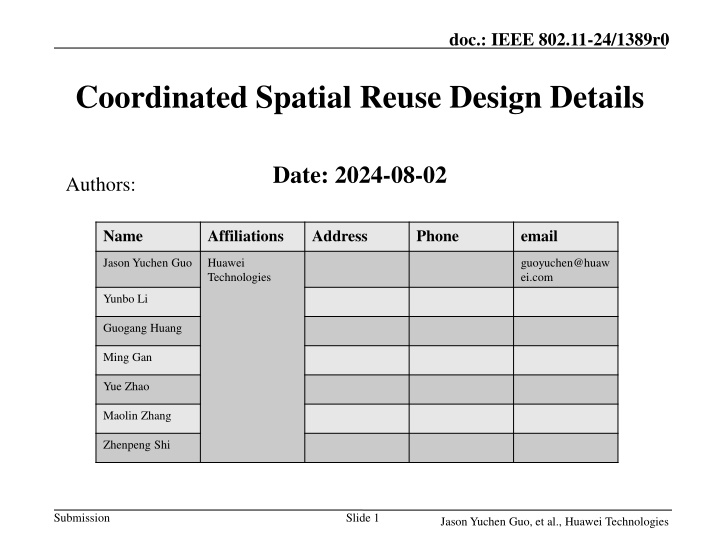
Coordinated Spatial Reuse Design Details in IEEE 802.11-24
Explore the detailed design aspects of Coordinated Spatial Reuse (CSR) proposed to enhance system throughput in a multi-AP environment. The discussion includes identification of shared APs, processing delays of CSR Trigger frames, and transmission procedures.
Download Presentation

Please find below an Image/Link to download the presentation.
The content on the website is provided AS IS for your information and personal use only. It may not be sold, licensed, or shared on other websites without obtaining consent from the author. If you encounter any issues during the download, it is possible that the publisher has removed the file from their server.
You are allowed to download the files provided on this website for personal or commercial use, subject to the condition that they are used lawfully. All files are the property of their respective owners.
The content on the website is provided AS IS for your information and personal use only. It may not be sold, licensed, or shared on other websites without obtaining consent from the author.
E N D
Presentation Transcript
doc.: IEEE 802.11-24/1389r0 Coordinated Spatial Reuse Design Details Date: 2024-08-02 Authors: Name Affiliations Address Phone email Jason Yuchen Guo Huawei Technologies guoyuchen@huaw ei.com Yunbo Li Guogang Huang Ming Gan Yue Zhao Maolin Zhang Zhenpeng Shi Submission Slide 1 Jason Yuchen Guo, et al., Huawei Technologies
doc.: IEEE 802.11-24/1389r0 Introduction Coordinated Spatial Reuse (CSR) has been proposed to improve system throughput and latency performance in multi-AP scenario [1-12]. The motion for defining CSR in TGbn has passed: Move to add the following text to the TGbn SFD: Define a multi-AP Coordinated Spatial Reuse at TxOP-level with power control Define multi-AP Coordinated Beamforming Other multi-AP coordination modes are TBD In this contribution, we discuss several aspects of design details of CSR, including: How to identify the shared APs The processing delay of CSR Trigger frame Submission Slide 2 Jason Yuchen Guo, et al., Huawei Technologies
doc.: IEEE 802.11-24/1389r0 Recap CSR transmission procedure Sharing AP obtains TXOP Sharing AP transmits a CSR Trigger frame to shared APs, the transmission duration and the transmit power of the APs are specified by the CSR Trigger frame All the APs transmit in parallel to their associated STAs AP1 Co-SR Trigger Frame DL Data Frame (sharing AP) AP2 DL Data Frame (shared AP) STA1 BA (Associated with AP1) BA STA2 (Associated with AP2) Note: how to transmit the BA is TBD Submission Slide 3 Jason Yuchen Guo, et al., Huawei Technologies
doc.: IEEE 802.11-24/1389r0 Identification of the shared APs The identification of the shared APs depends on how many shared APs do we want to support in a single CSR transmission Opt1: only one shared AP is allowed in one CSR transmission Opt2: two or more shared APs are allowed in one CSR transmission In opt1, we can use the MAC address of the shared AP as the identifier of the shared AP in the CSR Trigger frame, i.e., using the RA field In opt2, we need a procedure for the sharing AP to assign a short AP ID to each of the shared APs This can be done during the setup procedure, each AP can assign an AP ID to its peer AP. Submission Slide 4 Jason Yuchen Guo, et al., Huawei Technologies
doc.: IEEE 802.11-24/1389r0 Processing delay of CSR Trigger frame After receiving a CSR Trigger frame, the shared AP may need some time to process the CSR Trigger frame before transmitting data to its associated STA. There are several methods to handle this issue. Method 1: add padding to the CSR Trigger frame Method 2: allow the shared AP to start data transmission later than the sharing AP In method 1, we need a way for the shared AP to tell the sharing AP how much padding delay does it need This can be done during the setup procedure, each AP can indicate to its peer the needed padding delay In method 2, shared AP s associated STA may start receiving the sharing AP s DL packet, and may capture the shared AP s DL packet later (if the SIR is high enough). if the shared AP intends to use method 2, it can indicate a zero padding delay during the setup procedure. Submission Slide 5 Jason Yuchen Guo, et al., Huawei Technologies
doc.: IEEE 802.11-24/1389r0 Conclusion We propose several aspects of design details for CSR, including The number of shared APs The identification of shared APs The processing delay of CSR Trigger frame Submission Slide 6 Jason Yuchen Guo, et al., Huawei Technologies
doc.: IEEE 802.11-24/1389r0 References [1] 11-19-0103-01-0eht-ap-coordination-in-eht [2] 11-20-0576-01-00be-coordinated-spatial-reuse-protocol [3] 11-20-0107-01-00be-multi-ap-coordination-for-spatial-reuse [4] 11-22-1512-00-0uhr-Multi-AP Coordination for UHR [5] 11-22-1516-00-0uhr-Considerations on Multi-AP Coordination [6] 11-22-1822-00-0uhr-Recap on Coordinated Spatial Reuse Operation [7] 11-23-0058-00-0uhr-Spatial Reuse in Coordinated M-AP for UHR [8] 11-23-1037-00-0uhr-performance-of-coordinated-spatial-reuse [9] 11-23-0776-01-0uhr-performance-of-c-bf-and-c-sr [10] 11-23-1023-02-0uhr-coordinated-spatial-reuse-in-a-4-ap-topoplogy [11] 11-23-0616-00-0uhr-overhead-analysis-of-coordinated-spatial-reuse [12] 11-23-1868-02-00bn-coordinated-spatial-reuse-design Submission Slide 7 Jason Yuchen Guo, et al., Huawei Technologies
doc.: IEEE 802.11-24/1389r0 SPs SP1:Do you support to include in the 11bn SFD: In Coordinated Spatial Reuse: An AP can transmit a CSR Trigger frame to initiate simultaneous transmissions of two or more APs on the same frequency resource within its obtained TXOP; The transmission duration and the transmit power of the APs are specified by the CSR Trigger frame; The details of the CSR Trigger frame are TBD. Submission Slide 8 Jason Yuchen Guo, et al., Huawei Technologies
doc.: IEEE 802.11-24/1389r0 SPs SP2: How many shared APs do you support in a single CSR transmission: One; Two or more; Abstain. SP2a: Do you support to include in the 11bn SFD: In Coordinated Spatial Reuse: The number of shared APs that participate in a single CSR transmission is one SP2b: Do you support to include in the 11bn SFD: In Coordinated Spatial Reuse: The number of shared APs that participate in a single CSR transmission can be larger than one Submission Slide 9 Jason Yuchen Guo, et al., Huawei Technologies
doc.: IEEE 802.11-24/1389r0 SPs SP3: Do you support to include in the 11bn SFD: In Coordinated Spatial Reuse: AP can assign an AP ID to its peer AP during the setup procedure Submission Slide 10 Jason Yuchen Guo, et al., Huawei Technologies
doc.: IEEE 802.11-24/1389r0 SPs SP4: Do you support to include in the 11bn SFD: In Coordinated Spatial Reuse: AP can indicated its required CSR padding delay during the setup procedure, which is the minimum padding duration to be added in the CSR Trigger frame if the AP is identified by a CSR Trigger frame. Submission Slide 11 Jason Yuchen Guo, et al., Huawei Technologies

